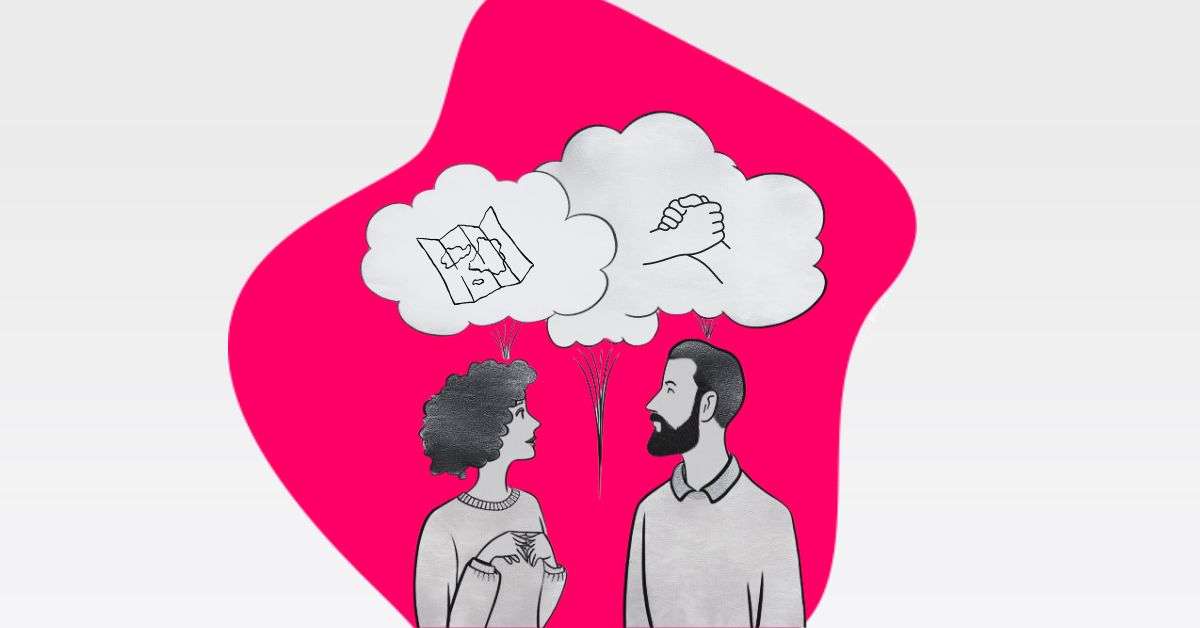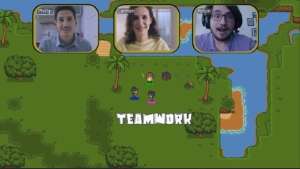Maximum effect with minimum effort: that’s the motto of the best team building games without materials! Because we believe that team building doesn’t have to be complicated and time-consuming to yield real effects!
Regular team building games not only strengthen team dynamics, but also unleash the individual potential of each team member. In this article, we’ll explore the unassuming but powerful world of team building games without materials that build and reinforce the foundations of a strong team culture.
We will talk about the following games:
Why team building without materials makes sense
Why should you choose team building games without materials? The purpose behind these games is to create an atmosphere where team members can improve their skills, interact with each other and build a strong connection without relying on physical resources. These games encourage creative collaboration, improve communication and create an environment that strengthens team dynamics. They offer the opportunity to break down barriers, achieve common goals and promote collaboration in a fun and engaging way. The use of imagination and sharing ideas is at the heart of these games to strengthen and connect the team not only professionally but also personally. Want more examples of team building games without materials? Check out our list of fun group games for adults to find a continuation of this list. We also compiled a list of fun & short team building games that will only cost 5-15 minutes of your day.
1. The Gordian Knot
This team building game, known as the “Gordian Knot”, focuses on collaboration and creative problem-solving within the team. It challenges the participants to overcome a seemingly inextricable situation without the use of any materials.
Goal:
The main aim of the game is to encourage team members to improve their collaboration and problem-solving skills. By working together to untangle a complex “knot”, the aim is to overcome obstacles and develop solutions that strengthen team dynamics.
Instructions:
The “Gordian Knot” can be played in any room without physical aids. The participants stand in a circle, join hands and intertwine them to form a knot. The aim is to untangle the knot without letting go of each other’s hands by moving, passing over or under each other until the original circle is restored.
The “Gordian Knot” is a challenging but rewarding exercise to strengthen teamwork and problem-solving skills. It encourages creative problem-solving and the ability to work together to overcome seemingly insurmountable obstacles. Working together to untangle the ‘knot’ not only strengthens team dynamics, but also promotes trust and support among team members.
2. Monax Island
Monax Island is an entertaining co-op browser game that only requires a laptop and a stable internet connection. Admittedly, this game is not entirely material-free. However, a laptop and internet are standard equipment for most employees anyway, especially if you want to play directly in the office. What’s more, you don’t have to download anything, just open a session online and have fun!
Goal:
The aim of the game is to escape from Monax Island with the help of cooperation and communication. On your way, you have to play fun mini-games and solve puzzles to reach the next level. The side quest is to learn more about the exciting storyline of Monax Island as you progress through the game. Because, surprise: the island is also inhabited by a mysterious species that you might want to watch out for…
Instructions:
One person starts the game session and shares the link with the rest of the team. The game can be played in teams of 2-6 people. Once everyone has arrived in the lobby, you can press start, and you will land at your starting point, the ship on which you will set off on your adventure. The rest, we don’t really want to spoil. 🤭
If, in addition to having fun, you also want to find out important information about the performance of your team and individual employees, Monax Island offers the option of using special AI Insights. Your personality is observed over the course of the game and the Insights collect data on cooperation, group dynamics and individual personalities.
3. The Invisible Landmine
This team-building game is all about trust and communication as the team navigates an invisible landmine. It’s not about physical obstacles, but about the mental challenge of finding a safe route together.
Goal:
The game aims to strengthen interpersonal relationships within the team by promoting trust and coordination in a unique way. It requires precise communication and a deep understanding of each other in order to master the challenges.
Instructions:
A conference room or office is all you need to successfully complete this team building task. Alternatively, you can also play outdoors. The participants imagine that the room is full of invisible landmines and have to work together to navigate safely through the room. Some of the participants are blindfolded (or simply closed) and must be guided through the minefield. Through clear verbal instructions and coordinated teamwork, they avoid the “mines” and move safely from one point to another.
Overall, “The Invisible Landmine” provides a challenging but extremely rewarding opportunity to strengthen the foundations of trust and communication within a team. It highlights the importance of precise instructions, active listening and trust in the abilities of team members. In the end, it’s about overcoming obstacles together and strengthening team dynamics through a fun but educational experience.
More Team Building Ideas please?
We have plenty, of course! Click through our favorite 30+ best team building games! Of course, we also have a list with online team games, if this is your thing.
4. The Alphabet
 This game focuses on improving communication and memory within the team. It is a creative way to build shared understanding and encourage collaboration without resorting to any physical materials.
This game focuses on improving communication and memory within the team. It is a creative way to build shared understanding and encourage collaboration without resorting to any physical materials.
Goal:
The aim of the game is to memorize what your teammates have said. Remembering and sharing information not only strengthens memory, but also collaboration. The aim is to build a bridge between individual mindsets and promote a collective understanding.
Instructions:
This game does not require any physical materials and can easily be played at the office, in a conference room or other confined space. Participants start by lining up and going through the alphabet together, with each team member naming a letter in order. The player must now name a word that begins with this letter. You can choose topics for this, e.g. objects in the office, zoo animals or food. The challenge is to remember the previously stated words and repeat them continuously. This creates a shared memory that strengthens cooperation and the group feeling.
5. Suitcase Packing
This team building game is, similar to the “Alphabeth”, a playful exercise that promotes creativity and coordination within the team without using physical materials. It encourages participants to take a virtual journey through movement and imagination.
Goal:
The main aim of this game is to stimulate the team members’ creativity while strengthening their coordination and cooperation. Above all, this game also promotes team dynamics.
Instructions:
The participants imagine that they are virtually packing suitcases for a trip. Each team member in turn adds an imaginary item and makes a movement to pack that item into the suitcase. For example, one team member could imagine putting a beach ball in the suitcase and combine this with a specific movement, while the next team member adds a swimming costume and performs a corresponding movement. The suitcase is packed and everyone has to memorize and imitate the movements of the others. This strengthens cooperation and creativity within the team.
This task provides an interactive way to promote creativity while improving team coordination. It encourages participants to embark on a virtual journey together and connect to the imaginary objects through movement, which strengthens collaboration and commitment to the common goal.
6. Wordy Scavenger Hunt
The “Wordy Scavenger Hunt” is an intriguing team building activity that takes the team through a virtual scavenger hunt based on words, riddles or clues. It’s a fun way to encourage team members to collaborate, solve puzzles and search for answers or solutions together.
Goal:
The aim of this game is to strengthen team spirit and at the same time promote the fun of solving puzzles. Participants are encouraged to put their heads together to decipher clues, solve puzzles and ultimately find a final solution. This not only promotes collaboration, but also the problem-solving skills of each individual.
Instructions:
The “Wordy Scavenger Hunt” does not require any physical materials, but can take place via various digital platforms or communication channels. Participants receive riddles or word games via text messages, emails or other digital means. These clues lead to further puzzles or tasks that the team must solve together in order to progress and reach the final goal of the scavenger hunt.
This game offers a fun and challenging way to build team spirit as it encourages team members to work together, think creatively and solve puzzles. The virtual nature of this game also offers flexibility and the ability to adapt it to different environments and situations, making it a versatile and popular team building activity. In the end, the “Scavenger Hunt of Words” creates an atmosphere of fun, collaboration and shared success as a team.
7. Role Reverse
The game “Role Reversal” is a remarkable exercise that goes far beyond a simple game. It encourages team members to step out of their usual comfort zones and put themselves into the shoes of their colleagues. This change of perspective allows each individual to empathize with the challenges, thought processes and decisions of other team members without the need for external aids.
Goal:
The main aim of this game is to strengthen understanding and empathy within the team. When team members take on the role of their colleagues, a deeper understanding of their perspectives, working methods and challenges is created. This not only promotes team spirit, but also creates an atmosphere of respect and openness within the team.
Instructions:
- Role assignment: Each team member takes on the role of another team member. They can imitate the role or act authentically, depending on the objective.
- Change of perspective: During this process, each team member puts themselves in the role of the assigned colleague and considers how they would act in certain situations.
- Reflection and discussion: After the roles have been reversed, the team members come together to reflect on their experiences. They share insights and discuss how this change of perspective has improved mutual understanding.
“Role reversal” opens up the opportunity for a profound experience that strengthens understanding and empathy within the team. As team members take on the positions of their colleagues, not only is cohesion strengthened, but also the ability to see the world from different perspectives. This game creates an atmosphere of respect and openness, which helps to promote healthy team dynamics.
Big Group Entertainment?
You have a large group to entertain? Then check out our favorite games for big groups!
8. Picture Memory
 The “Picture Memory” challenge is a fun and creative team building activity based on the dynamic between description and creativity. One person describes something, be it a picture, a scene or a concept, while the other person tries to draw or visualize it based on this description.
The “Picture Memory” challenge is a fun and creative team building activity based on the dynamic between description and creativity. One person describes something, be it a picture, a scene or a concept, while the other person tries to draw or visualize it based on this description.
Goal:
The main objective of this challenge is to encourage communication between the team members while stimulating their creativity. The person giving the description must provide clear and precise instructions, while the other person uses their ability to interpret and translate the description into a drawing.
Instructions:
- Description: One person describes an image, scene or concept without the other person seeing it.
- Visualization: The other person listens attentively and tries to draw the described object or scene based on this description.
- Comparison and reflection: Once the drawing has been completed, it is compared with the original. The team members exchange their perspectives and reflect on the challenges and experiences during the process.
The “Visualization Challenge” provides a great opportunity for improved communication and a playful way of working together. Through this task, the ability to communicate and interpret clearly is strengthened, while at the same time the creative streak of each team member is encouraged. The end result is not only a series of fun and perhaps unexpected drawings, but also a deeper understanding of the importance of clear communication and interpretive skills within the team.
Sign-off
Team building games without materials offer a flexible solution to connect teams and improve their dynamics. The ability to integrate complex concepts into fun activities highlights the importance of these games, not only for professional success, but also for the general well-being and motivation of team members.
Overall, these games show that team building is not always dependent on physical resources. The true essence lies in shared commitment, creativity and mutual understanding. By integrating such games into everyday team life, teams can not only work more effectively, but also build a positive and supportive work culture. The path to success is not only the destination, but also the journey that we create and enjoy together.







